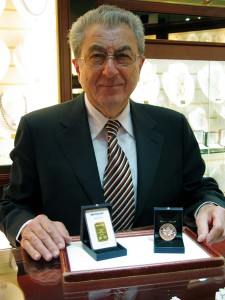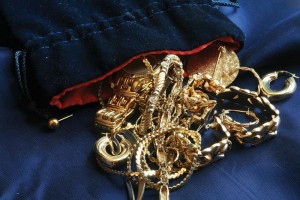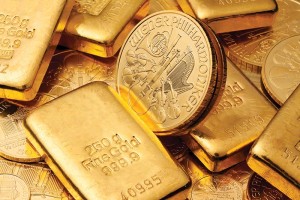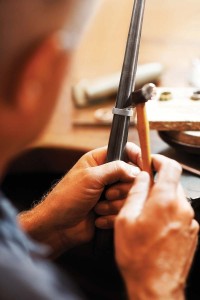Good as gold: How you can make the most of the cash-for-gold business
by charlene_voisin | June 1, 2012 9:00 am
By Jeff Green

Economic pressures from beyond the borders of the jewellery business created the cash-for-gold market—and they’re keeping it going, too.
Whether gold is trading at record highs of more than $1900 US per ounce or lower, it’s a fact the price is as fluid as scrap chains and dated charms when they hit the heat of the induction furnace. While not a new trend, the ups and downs of the gold market are keeping the cash-for-gold business going, say refiners.
“It’s pretty much gambling on the spike in the price of gold,” says Tom Petrovski, a partner at CNC Gold Refining in Toronto. A gamble that is necessary for today’s jewellers, he adds.
“Jewellery stores had to start buying back gold because certain jewellery just wasn’t selling,” Petrovski explains. “They had to get into it and if they didn’t, I’m pretty sure they were tapping into reserves.”
Driven by a collapse in global markets, gold prices soared to record levels as investors looked to the precious metal as a safe haven against economic volatility. In the meantime, consumers emptied their drawers and literally liquidated heirlooms.
When gold begins to plateau, however, that’s when it may be time to get out. Without the spikes in price, Petrovski says, the opportunities for profits are slimmer.
“That’s when there’s not going to be much gold buying [by retailers] and there’s not going to be much selling [by consumers],” he adds. But until then, if you’re not in the cash-for-gold business, you’re potentially losing out on the traffic it brings, while your competitor may not be.
It’s a missed opportunity, some say, on the part of jewellers who have stayed clear of the trend, feeling instead it may tarnish their brand, says Thomas Jansseune, managing director at Imperial Smelting and Refining in Markham, Ont. “They feel it downgrades what they are doing.” However, he adds retailers have become more receptive to the idea that buying back gold can complement their business. Jansseune notes this can be particularly valuable in a rough economy. “Some say it helps them get to the end of the month,” he says.
Making a splash

In a tough economy, Ara Run says it’s getting harder and harder to get people through the wooden French doors of his store, Exclusive Diamonds, in Toronto’s Sherway Gardens. So for the past year, he’s turned the tables, so to speak. Rather than just buying back precious metals, he’s been selling gold and silver wafers, coins, and bars, bringing the physical commodity right to his storefront and allowing his clients to skip the mint or the bank.
“I always look for new ideas because we don’t do a lot of advertising,” Run says. “Selling physical gold and silver brings in a little bit of action.”
Run says he sells solid gold from one-ounce sizes, all the way down to 1/10 of an ounce. He doesn’t charge much over the market price. “Just $50,” he says, adding customers are willing to pay slightly more for the convenience of simply walking into a store, as opposed to going through the mint.
He’s the only jewellery retailer he’s aware of offering physical metal, and adds he got into the business when gold prices went through the roof.
 “It’s an old custom for many Europeans to give gold coins as gifts, so I thought that the way the gold prices are going up, instead of buying those medallions”¦ they could buy bars,” says Run.
He keeps a sign in his window advertising his cash-for-gold business, but shies away from an aggressive marketing campaign.
“We do it in a nicer way,” Run says, noting the main benefit to his operation has not been from selling the wafers and bars themselves, but rather the traffic it has produced in his store. Interest, Run says, is what he was after.
A new clientele

Selling gold has become so widespread, it’s no longer a practice reserved for people desperate for cash.
According to Jansseune, it has become acceptable in the mainstream, partly due to how easy it’s become to trade in gold for cash. Even luxury chain store Birks offers a gold exchange program, with consumers receiving a discount off their next purchase.
“There’s a lot of dated jewellery”¦ so why not bring it in and make something new of it?” asks Lorne Spivak, owner of Samuel Kleinberg Jewellers in Toronto.
Spivak, who has always traded gold for store credit, has successfully used a buyback program to lure new customers in, and trigger his existing clientele to upgrade their current jewellery.
“It was very well-received by our clientele,” says Spivak, who’s been running the campaign since last November.
For every $1000 he buys back, Spivak gives out $250 in credit toward a future purchase. “It’s a good complementary business,” he says. “There’s nothing negative about it.”
Making the most of cash-for-gold

For retailers that have yet to enter the cash-for-gold business, Rafael Amador, a sales executive with United Precious Metals Refining (UPM) in New York, suggests doing a little research about what the various refiners charge for taking in gold scrap.
“That’s going to vary immensely between different refiners,” says Amador.
Everyone has a refining fee, but there are also fees for the lot, along with assay charges to determine the quality of gold and its various alloys. Some companies offer free shipping, while others do not.
It all adds up, Amador says, and profit margins can vary greatly, depending on which refiner you choose.
Once you’ve found your refiner, Amador stresses the importance of accuracy and the ability to test the gold you’re buying.
“We see a lot of jewellery that is stamped 14-karat, but it’s really 12,” he notes.
At UPM, gold is assayed after it’s melted, and retailers are paid based on the ‘report card’ of information they get back from testing, rather than the stamp on the gold itself.
Do your homework

‘Turn and burn’ is a phrase Amador says is used a lot in his business, more from his newest cash-for-gold clients. As retailers play the market, turnaround time becomes a key factor—should you sell your lot quickly, opting for the markup and taking the stability of the rate at which it was traded? Or is it better to hold onto gold, hoping the price spikes for a significantly better profit?
Amador says many of his cash-for-gold clients have a relatively quick turnaround time. “They need the money fast,” he adds.
Petrovski agrees, adding a quick turnaround is the “safest bet,” since the price of gold can fluctuate drastically daily. A $50 to $60 swing in either direction is not unheard of, and can potentially cut into a retailer’s margins.
But not everyone is jumping on the cash-for-gold bandwagon. Jeff Buzbuzian of Knar Jewellery says he doesn’t have the staff to manage all that comes with it.
“I know it’s a business, but it’s a different beast for sure,” Buzbuzian says from his Guelph location.
Instead, he says his focus remains on his existing clientele, and that while he has many friends and colleagues in the cash-for-gold market, he’s sticking with selling finished and custom jewellery.
While it may have gotten its start in light of the U.S. economic meltdown, uncertainty in Europe has helped drive up the price of gold and created an entire industry.
Jansseune believes the cash-for-gold market is showing no signs of slowing down. “It will remain strong and steady for some months and maybe years ahead.”
Jeff Green is a Hamilton-based journalist and freelance writer. He’s covered breaking news, business, and sports for daily and weekly newspapers, as well as for the Canadian Press. Green was nominated for a pair of Ontario Newspaper Awards for his work in this, his first year as a full-time journalist.
Source URL: https://www.jewellerybusiness.com/features/good-as-gold-how-you-can-make-the-most-of-the-cash-for-gold-business/